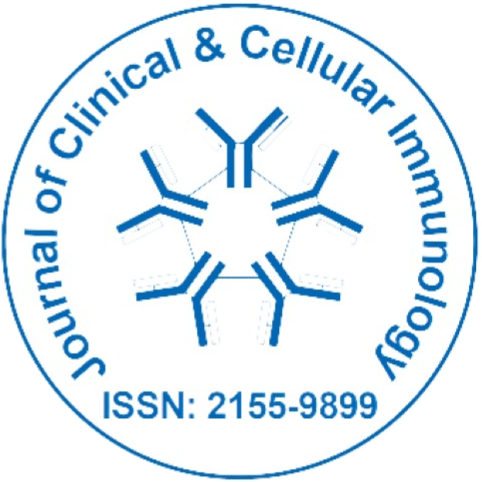
Journal of Clinical and Cellular Immunology
Open Access
ISSN: 2155-9899

ISSN: 2155-9899
Short Communication - (2016) Volume 7, Issue 6
Keywords: HSP70; Cancer; Biomarkers; Targeted therapy; Exosomes; Extracellular vesicles; Translational research
Exosomes are cell-secreted nanovesicles (70-150 nm diameters) of endosomal origin (Figure 1) [1]. They have recently aroused a great interest in the scientific and clinical community for their roles in intercellular communication in almost all physiological and pathological processes [2-5]. All cells can secrete exosomes and the released exosomes share with the parent cell a similar lipid bilayer with transmembrane proteins and a panel of enclosed soluble proteins and RNAs [6,7]. The tightly controlled secretion process is being deciphered. For instance, it has been shown that the release of exosomes and microvesicles from adipocytes is significantly reduced upon inhibition of histone H3 lysine9 methyltransferase G9a and histone H3 lysine4 demethylase LSD1 [8]. This observation indicates that both H3K9me2 and H3K4me3 might be essential for the secretion of exosomes in mammalian cells. Interestingly, as a recent article revealed, histone methyltransferase G9a also maintains DNA methylation at imprinted loci with its G9a-like protein partner in embryonic stem cells, indicating that aberrant distribution of DNA methylation might also affect the secretion of exosomes [9]. Surface receptors allow the targeting and capture of exosomes by recipient cells, while the exosomes’ content can modify the physiological state of recipient cells. Thus, exosomes may be further investigated to confirm their potential: (i) as biomarker in various diseases to facilitate the diagnosis of disorders prior to health deterioration and/or (ii) as targets to be inhibited or eliminated to improve patients’ health [10-14].
Figure 1: Schematic representation of exosome biogenesis and secretion: exosomes are formed by budding into early endosomes and multi-vesicular bodies. These can either fuse with lysosomes for degradation or with the plasma membrane where they release their content into the extracellular medium. Hence, exosomes share with the parent cell a similar lipid bilayer with transmembrane proteins and a panel of enclosed soluble proteins as well as RNAs. The wellcontrolled process of biogenesis, transport and secretion requires a panel of actors that are currently being identified.
We and others previously demonstrated in vitro and in vivo that although all tumor cells secrete exosomes with heat shock protein-70 (HSP70) in their membrane, non-cancerous cells do not. It has been shown that HSPs are able to associate to toll-like receptors (TLR). For instance, in some cells, HSP70 can associate to TRL4 while HSP27 binds to TLR3 [15-17]. In “Restoring anticancer immune response by targeting tumor-derived exosomes with a HSP70 peptide aptamer” we show that exosomes, via HSP70 expressed in their membrane, are able to interact with TLR2 on myeloid derived suppressive cells (MDSC) thus activating them [18]. These cells play a major role in cancer progression, so we investigated whether inhibition of HSP70 on the exosomes could actually restore an anti-cancer immune response [19]. To this end, we developed a high-affinity peptide aptamer, called A8, which binds to the extracellular domain of membrane-bound HSP70 [20,21].
We used different techniques (including nanoparticle tracking analysis (NTA) and biolayer interferometry (BLI)) to show that membrane HSP70 in exosomes binds to A8 with higher affinity than to TRL2. We demonstrate that by doing so, A8 can block the ability of HSP70-exosomes to activate MDSC. In vivo , a decrease in MDSC induced by A8 is associated to an efficient anti-tumor response. Indeed, activated MDSC inhibits T-cells. As a consequence, there is an inhibition in the anti-tumor immune response notably less intra-tumor infiltration of cytotoxic T-cells and macrophages and these intra-tumor immune cells infiltration are associated to tumor regression. Concerning cytokines secretion, IFN-gamma is also strongly inhibited by MDSC activated by tumor-derived exosomes. It would be interesting to study the involvement of Treg cells in the pro-tumor effect induced by tumor-derived exosomes and MDSC.
Further, we demonstrate that the release of HSP70-exosomes seems a general feature of cancer cells (but not of “normal” non-cancerous cells) and that they can be easily quantified from cancer patients’ urines and blood samples using A8 as a ligand in a BLI biolayer interferometry approach. Altogether, we demonstrate using our A8 peptide aptamer that exosomes expressing HSP70 in their membrane can be detected and targeted in a theranostic approach.
These results contribute to open many perspectives for researchers working not only in cancer therapy but also in diagnosis. Indeed, the main advantage of quantifying tumor-derived exosomes compared to circulating tumor cells (CTCs) is that exosomes are found in large amounts compared to CTCs and that exosomes can be quantified noninvasively in urines [22]. To move beyond the proof of principle that tumor-derived exosomes (HSP70-exosomes) can be quantified and might be interesting to follow up cancer patients, we have started a prospective study with the anticancer Centre Georges-François Leclerc (CGFL, Dijon, France) in breast and lung cancer aiming at determining whether the presence of HSP70-exosomes is predictive of the patients’ outcome and whether their detection precedes CTCs and the apparition of metastases.
There is no doubt that even if there are many key questions remaining to be answered, the relatively young field of exosomes is gaining greater interest within the scientific and medical communities [5].
This work was supported by the Institut National du Cancer, the Agence Nationale de la Recherche, the Conseil Regional de Bourgogne, La Ligue Nationale contre le Cancer, the “Association pour la Recherche sur le Cancer” (ARC), the French Government grant managed by the French National Research Agency under the program “Investissements d’Avenir” with reference ANR-11-LABX-0021 (LabEX LipSTIC), the FEDER, the BQR and the PARI Nano2Bio.
GM, JG, RS and CG declare competing financial interests.